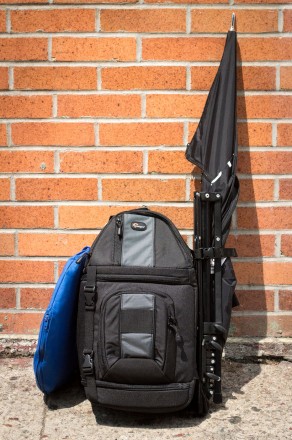Small Flash: On-Location Lighting Kit | KelbyOne
Join Erik in this post as he shares his tips for building yourself an on- location lighting kit
Light exists in so many forms: natural, artificial, hard, soft, warm, cool. And the word, “light,” also has many meanings. In this article, we’ll cover the marriage of traveling light while packing the right tools to control and capture light when shooting on location. When you leave the comfort of your studio, it’s not practical to pack every piece of gear you own (plus the kitchen sink). At the same time, you don’t want to find yourself out on location missing a vital piece of equipment. That’s why packing efficiently becomes an art form unto itself.
Step One
Many times when I’m shooting without an assistant, it means using only what I can carry on my back. That’s why ultraportable begins with bag selection. No one wants to climb a mountain, or even trek across the local park, with a 100-lb case of gear. Using a backpack vs. a roller bag gives you ultraportability and keeps you honest—when the backpack is full, that’s all you’re walking out the door with. I prefer the sling-bag type of backpack, like the Lowepro SlingShot 202 AW.
A bag like this can be comfortably carried on your back, and then swung around in front to give you quick access to your camera. You don’t have to take the bag off and set it on the ground. And, if you’re shooting in the sand or a wet environment, keeping your bag off the ground is critical.
Step Two
Next, decide what gear gets to fill that valuable real estate on your back: a camera is a given, plus some extra batteries; but do you really need that heavy external battery grip? Unless you’re shooting sports, the answer is probably “no.” Next up, lenses. I love my primes (love them)! If I’m traveling light, however, instead of packing 24mm, 35mm, 50mm, and 85mm primes, my go-to lens is the versatile 24–70mm f/2.8.
This saves a ton of room and weight and allows me to portray different perspectives without ever changing my lens.
On top of that, I always bring a little light of my own in the form of a small flash (or three). To reliably trigger this flash, I use PocketWizard FlexTT5 radio transceivers. They’re compact, work interchangeably on top of the camera and on your flash, plus they have built-in hot shoes, which means that you don’t have to remember to pack separate sync cables—one less thing that you might forget.
Step Three
The other piece of gear that goes with me everywhere is a standard reflector. With its multiple fabrics, a reflector is the most versatile light modifier out there, and it can work with both natural light and small flash. To get this versatility though, you’ll need all the different surfaces: white, silver, gold, black, and translucent. Rather than carrying around five different reflectors, you can have them all in one package by simply purchasing a 5-in-1 reflector with removable covers.
Although this won’t actually fit inside your bag, you can quickly hook it to your backpack with a simple carbineer as you’re heading out the door.
This kit alone is enough to make a great portrait by diffusing the sun with the translucent reflector panel and bouncing some fill light in from below with the removable silver material.
Step Four
Finally, I love to add light when and where I can. To do this, I need to have something to put the flashes on, but it’s not the time to pack a heavy-duty steel C-stand. (It’s going on your back after all, so think much lighter.) This is where the Manfrotto Nano stand really shines. Made of lightweight aluminum, it opens to over 6’ high, and then it collapses in on itself to tiny proportions—perfect!
Now, we just need to shape the light, and we’ll be ready to start firing away. A softbox provides directional light and soft light in the same package, but usually requires you to attach it to your flash with heavy speed rings, which rules them out for our ultraportable kit. Thankfully, Westcott has a line of Apollo softboxes that are built on a superlight, easy-to-setup umbrella frame, solving the problem. This makes it a no-brainer decision for the final piece of our kit.
This image was shot just before sunrise after a brisk hike out into an overgrown field. Waking up very early is hard enough, but can you imagine having to lug around a ton of gear, too?
Learning to pack light and smart frees you to get to your location quickly, and then focus on the fun stuff, the photography!








